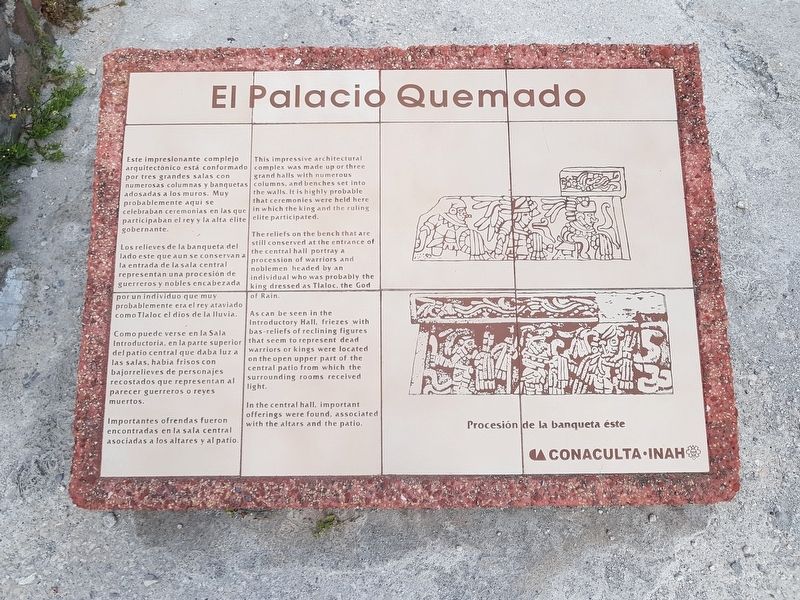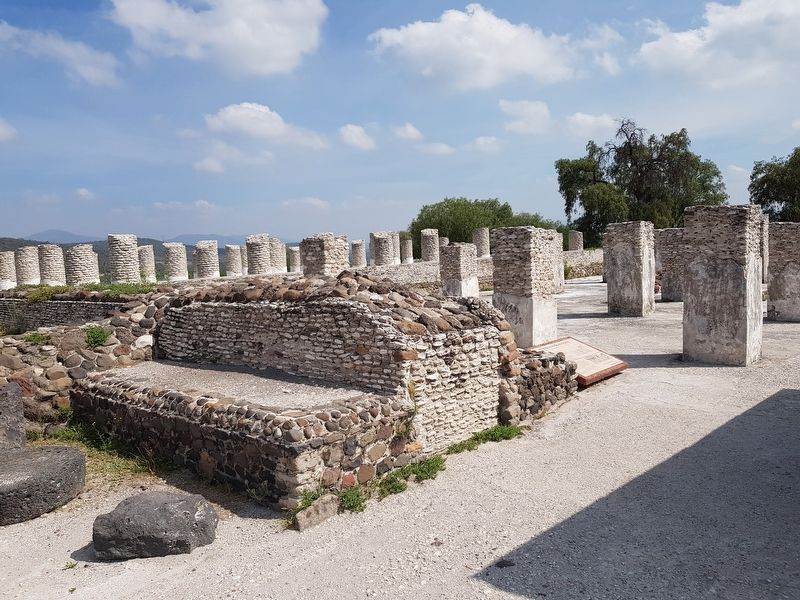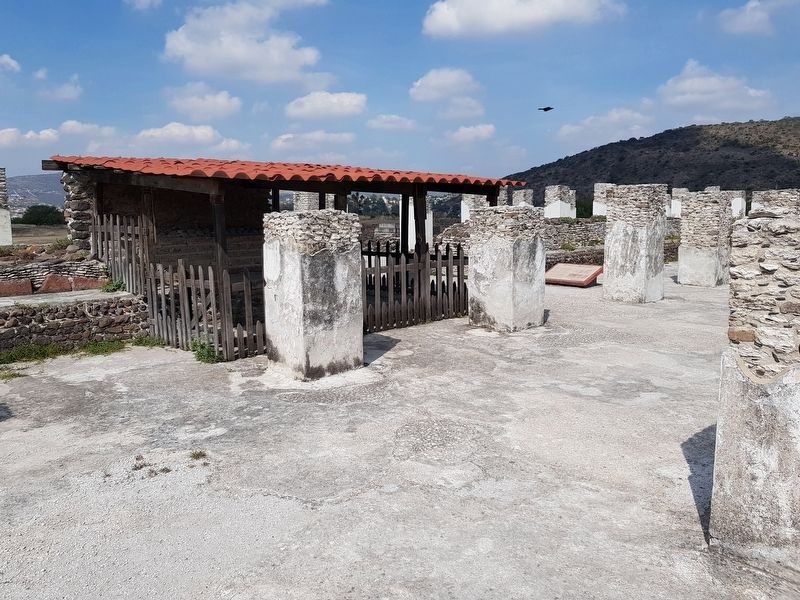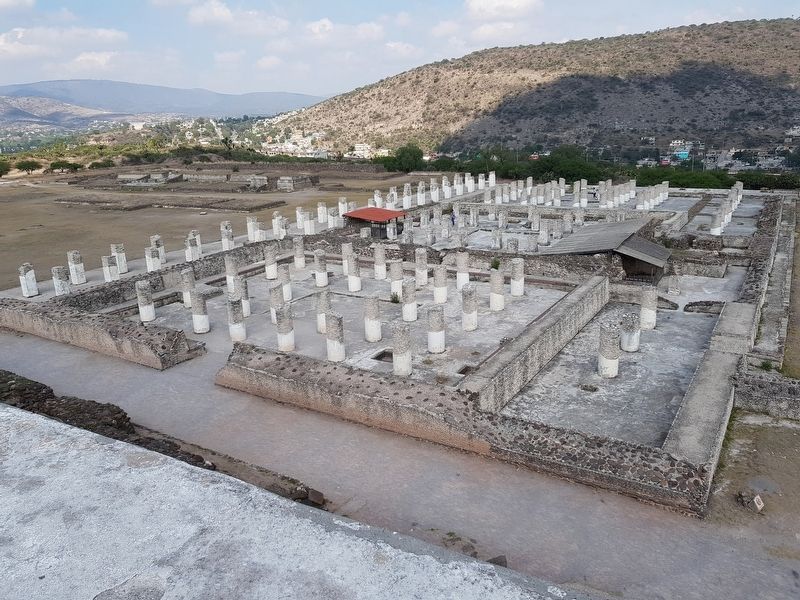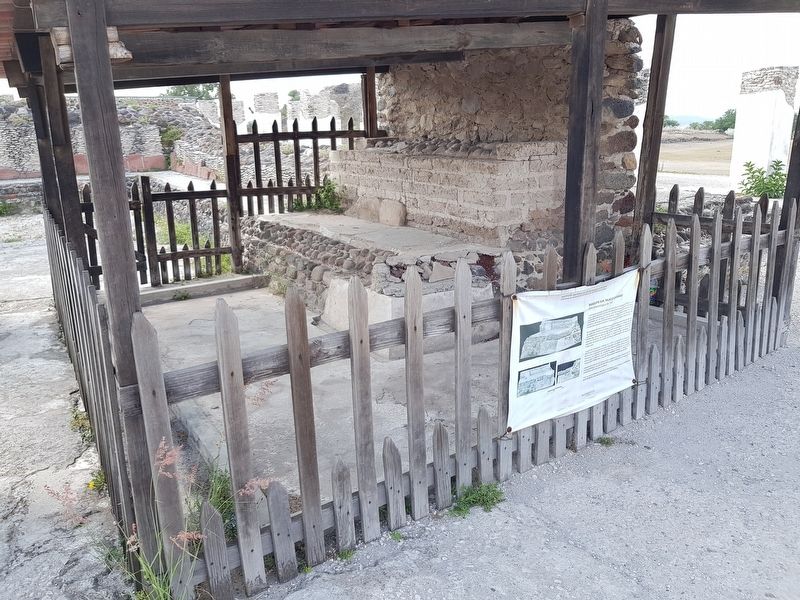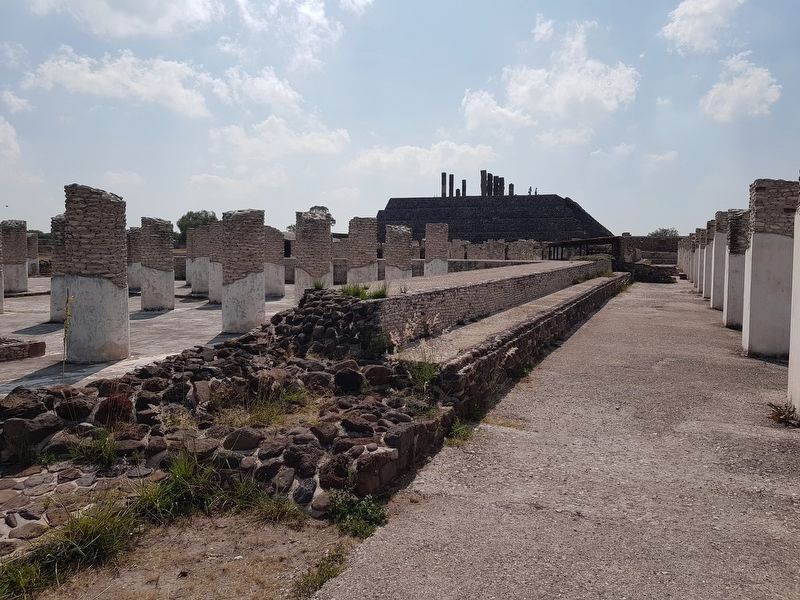Tula de Allende, Hidalgo, Mexico — The Central Highlands (North America)
The Burnt Palace
Este impresionante complejo arquitectónico está conformado por tres grandes salas con numerosas columnas y banquetas adosadas a los muros. Muy probablemente aquí se celebraban ceremonias en las que participaban el rey y la alta élite gobernante.
Los relieves de la banqueta del lado este que aun se conservan a la entrada de la sala central representan una procesión de guerreros y nobles encabezada por un individuo que muy probablemente era el rey ataviado como Tlaloc el dios de la lluvia.
Como puede verse en la Sala Introductoria, en la parte superior del patio central que daba luz a las salas, había frisos con bajorrelieves de personajes recostados que representan al parecer guerreros o reyes muertos.
Importantes ofrendas fueron encontradas en la sala central asociadas a los altares y al patio.
Pie de dibujo: Procesión de la banqueta éste
The Burnt Palace
This impressive architectural complex was made up or three grand halls with numerous columns, and benches set into the walls. It is highly probable that that ceremonies were held here in which the king and the ruling elite participated.
The reliefs on the bench that are still conserved at the entrance of the central hall portray a procession of warriors and noblemen headed by an individual who was probably the king dressed as Tlaloc, the God of Rain.
As can be seen in the Introductory Hall, friezes with bas-reliefs of reclining figures that seem to represent dead warriors or kings were located on the open upper part of the central patio from which the surrounding rooms received light.
In the central hall, important offerings were found, associated with the altars and the patio.
Caption: Procession of the eastern bench
Erected by CONACULTA y INAH.
Topics. This historical marker is listed in these topic lists: Anthropology & Archaeology • Architecture • Native Americans.
Location. 20° 3.851′ N, 99° 20.466′ W. Marker is in Tula de Allende, Hidalgo. Marker can be reached from Tula-Pachuca Carretera just north of Entrada a Zona Arqueológica. The marker is near the center of the Palacio Quemado at the Tula Archaeological Site. Touch for map. Marker is in this post office area: Tula de Allende HGO 42800, Mexico. Touch for directions.
Other nearby markers. At least 8 other markers are within walking distance of this marker. The Wall of Skulls (within shouting distance of this marker); Pyramid B (within
shouting distance of this marker); El Coatepantli (Wall of Snakes) (within shouting distance of this marker); The Temple of Pyramid B (within shouting distance of this marker); Ball Court 2 (about 90 meters away, measured in a direct line); Pyramid C and the Adoratory (about 90 meters away); Ball Court 1 (about 120 meters away); Building K (about 150 meters away). Touch for a list and map of all markers in Tula de Allende.
Additional commentary.
1. Text of temporary information about the Southern Bench at the Burnt Palace
Zona arqueologica de Tula
La banqueta se localiza al interior de lo que fuera una habitación porticada y con patio central ubicada en el centro del Palacio Quemado, por estar en el extremo sur de dicha habitación, se le conoce como “Banqueta Sur”. Este elemento está conformado por un talud y una moldura, ambos manufacturados en toba volcánica y decorados con bajorrelieves policromados en su cara frontal, capa de color de la que sólo se observan vestigios
de rojo, amarillo, blanco y azul.
De esta banqueta sólo se conserva la esquina suroeste, constituida por dos losas de piedra que conforman el talud y una de la moldura. Los relieves del lado norte representan a tres personajes de perfil, ornamentados con vestimentas y tocados que caminan hacia el lado oeste, mientras que la cara oeste, se observan evidencias de lo que serían la cabeza de dos personajes. En el fragmento de moldura es posible identificar la representación de una serpiente emplumada.
A partir del diagnóstico realizado en el 2014, se determinó la necesidad de desmontar la banqueta para poder trasladarla a los talleres de la Coordinación Nacional de Conservación del Patrimonio Cultural del INAH, espacio en el que se realizarán los procesos de restuaración que le devolverán su estabilidad estructural y recupererá parte de las cualidades visuales y estéticas de los relieves. Este trabajo está a cargo de restauradores especialistas del INAH.
Además de las labores de conservación, se realizará un trabajo interdisciplinario con arqueólogos y arquitectos del INAH, quienes colaboran en la mejora de las condiciones generales de su contexto.
Una vez que se finalice la adecuación del espacio y se concluya la restauración de la banqueta, esta será recolocada en su lugar original.
Instituto Nacional de Antropología E Historia
Coordinación
Nacional de Conservación del Patrimonio Cultural
The Southern Bench, The Burnt Palace
Tula Archaeological Zone
The bench is located inside what was a porticoed room with a central courtyard located in the center of the Burnt Palace. Because it is at the southern end of the room, it is known as "the Southern Bench". This element is conformed by a sloped area and a molding, both manufactured in volcanic tuff and decorated with polychrome bas-reliefs on its front face, a layer of color of which only traces of red, yellow, white and blue are observed.
Only the southwest corner, consisting of two stone slabs that make up the slope and one of the molding, is preserved of this bench. The reliefs on the north side represent three characters in profile, decorated with costumes and headdresses that walk to the west side. On the west side, evidence of what would be the head of two characters are observed. In the molding fragment it is possible to identify the representation of a feathered serpent.
Based on the diagnosis made in 2014, the need to dismantle the bench to move it to the workshops of the National Coordination of Conservation of Cultural Heritage of INAH, a space in which the restoration processes can be carried out that will restore structural stability and will recover part of
the visual and aesthetic qualities of the reliefs. This work is in charge of specialist restorers of the INAH.
In addition to the conservation tasks, interdisciplinary work will be carried out with INAH archaeologists and architects, who collaborate in the improvement of the general conditions of their context.
Once the adaptation of the space is completed and the restoration of the bench is completed, it will be re-positioned in its original place.
National Institute of Anthropology and History (INAH)
National Coordination for the Conservation of Cultural Heritage
— Submitted June 8, 2018, by J. Makali Bruton of Accra, Ghana.
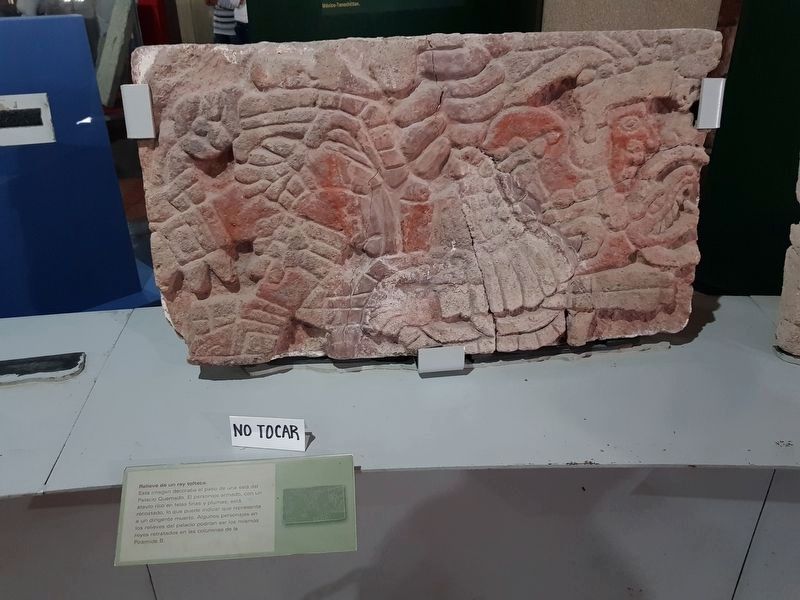
Photographed By J. Makali Bruton, June 2, 2018
6. A relief removed from The Burnt Palace
This relief can be seen at the nearby museum at the Tula Archaeological Site. It reads:
Relieve de un rey tolteca.
Esta imagen decoraba el patio de una sala del Palacio Quemado. El personaje armado, con un atavío rico en telas finas y plumas, está recostado, lo que puede indicar que representa a un dirigente muerto. Algunos personajes en los relieves del palacio podrían ser los mismos reyes retratados en las columnas de la Pirámide B.
English translation:
Relief of a Toltec king.
This image decorated the courtyard of a hall of the Burnt Palace. The armed character, with a garment rich in fine fabrics and feathers, is reclining, which may indicate that he represents a dead leader. Some characters in the reliefs of the palace could be the same kings portrayed in the columns of Pyramid B.
Esta imagen decoraba el patio de una sala del Palacio Quemado. El personaje armado, con un atavío rico en telas finas y plumas, está recostado, lo que puede indicar que representa a un dirigente muerto. Algunos personajes en los relieves del palacio podrían ser los mismos reyes retratados en las columnas de la Pirámide B.
Relief of a Toltec king.
This image decorated the courtyard of a hall of the Burnt Palace. The armed character, with a garment rich in fine fabrics and feathers, is reclining, which may indicate that he represents a dead leader. Some characters in the reliefs of the palace could be the same kings portrayed in the columns of Pyramid B.
Credits. This page was last revised on January 4, 2024. It was originally submitted on June 8, 2018, by J. Makali Bruton of Accra, Ghana. This page has been viewed 204 times since then and 25 times this year. Photos: 1, 2, 3, 4, 5, 6, 7. submitted on June 8, 2018, by J. Makali Bruton of Accra, Ghana.
